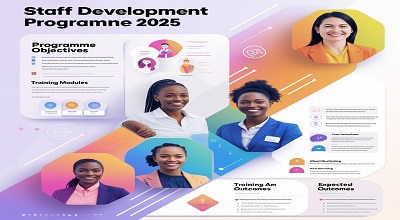Staff Development Programme
Staff Development Programme: In today’s rapidly evolving workplace, continuous learning and professional growth are essential for both employees and organizations. A Staff Development Programme (SDP) is a structured approach to enhancing employees’ skills, knowledge, and competencies to meet organizational goals.
As we step into 2025, businesses and educational institutions must adapt to new technologies, remote work dynamics, and changing industry demands. This article explores the latest trends, examples, and strategies for effective staff development programmes in 2025.
Importance of Staff Development in 2025
Staff development is no longer optional—it’s a necessity. Here’s why:
- Adapting to Technological Advancements – AI, automation, and digital tools require upskilling.
- Enhancing Employee Retention – Employees stay longer when they see growth opportunities.
- Boosting Productivity – Well-trained staff perform better and innovate more.
- Meeting Industry Standards – Compliance and industry best practices evolve constantly.
- Supporting Remote & Hybrid Work – New skills are needed for virtual collaboration.
Key Trends in Staff Development for 2025
A. Microlearning & Bite-Sized Training
Short, focused modules (5-10 minutes) via apps like Udemy, Coursera, or LinkedIn Learning.
B. AI-Powered Personalized Learning
AI-driven platforms like Degreed & EdCast recommend courses based on employee roles and progress.
C. Gamification & Interactive Learning
Badges, leaderboards, and simulations increase engagement (e.g., Kahoot! for corporate training).
D. Virtual Reality (VR) & Augmented Reality (AR) Training
Immersive experiences for technical skills (e.g., VR safety training for engineers).
E. Focus on Soft Skills
Emotional intelligence, leadership, and adaptability training are in high demand.
F. Peer Learning & Mentorship Programs
Employees learn from colleagues through structured mentorship initiatives.
Types of Staff Development Programmes
| Type | Description | Example |
|---|---|---|
| On-the-Job Training | Learning while performing tasks | Shadowing a senior employee |
| Workshops & Seminars | Short-term skill-building sessions | Leadership workshop by Harvard Business School |
| E-Learning Courses | Online self-paced courses | Google’s Digital Garage certifications |
| Coaching & Mentoring | One-on-one guidance | Executive coaching for managers |
| Job Rotation | Employees switch roles temporarily | A marketing specialist working in sales for 3 months |
| Conferences & Networking | Industry events for exposure | Attending SHRM Annual Conference |
Examples of Effective Staff Development Programmes in 2025
Example 1: Google’s “Grow with Google” Initiative
- Offers free digital skills training in AI, cloud computing, and data analytics.
- Uses AI-driven recommendations for personalized learning paths.
Example 2: Amazon’s Upskilling 2025 Program
- $1.2 billion investment in employee education.
- Courses in machine learning, robotics, and healthcare.
Example 3: Microsoft’s LinkedIn Learning Integration
- Employees access 16,000+ courses on leadership, tech, and creativity.
- Skill assessments & certifications validate progress.
Example 4: Deloitte’s Leadership Academy
- VR-based leadership simulations for real-world decision-making.
- Gamified learning paths to track progress.
Example 5: IBM’s AI Skills Academy
- Trains employees in AI, blockchain, and quantum computing.
- Badge-based credentialing for completed courses.
Steps to Implement a Successful Staff Development Programme
- Assess Organizational Needs – Identify skill gaps via surveys & performance reviews.
- Set Clear Objectives – Define measurable goals (e.g., “Improve leadership skills by 20%”).
- Choose the Right Training Methods – Blended learning (online + in-person).
- Engage Employees – Get feedback and encourage participation.
- Monitor Progress – Use LMS (Learning Management Systems) like Moodle or TalentLMS.
- Evaluate & Improve – Collect feedback and refine the programme.
Measuring the Success of Staff Development Programmes
- Employee Performance Metrics (KPIs, productivity levels)
- Feedback Surveys (Net Promoter Score – NPS)
- Certification & Completion Rates
- Retention & Promotion Rates
- ROI Analysis (Cost vs. Benefits)
Challenges and Solutions in Staff Development
| Challenge | Solution |
|---|---|
| Low Employee Engagement | Gamification & rewards |
| Budget Constraints | Free online courses (Coursera, edX) |
| Time Limitations | Microlearning & flexible schedules |
| Keeping Content Updated | AI-driven content curation |
Future of Staff Development Programmes
- AI-Driven Mentors – Chatbots providing real-time coaching.
- Neuroscience-Based Training – Brain-friendly learning techniques.
- Blockchain for Credentials – Secure, verifiable digital certificates.
- Holistic Well-being Programs – Mental health & mindfulness training.
Conclusion
The Staff Development Programme 2025 must be adaptive, tech-driven, and employee-centric. Organizations investing in continuous learning will thrive in the evolving workforce landscape.
By leveraging AI, VR, gamification, and mentorship, businesses can create a culture of growth and innovation.
FAQs
Q1. What is a Staff Development Programme?
A structured plan to enhance employees’ skills through training, workshops, and mentorship.
Q2. Why is staff development important in 2025?
Due to rapid tech changes, remote work, and the need for upskilling.
Q3. What are the best staff development methods in 2025?
Microlearning, AI-powered training, VR simulations, and peer mentoring.
Q4. How can companies measure the success of staff development?
Through KPIs, employee feedback, certification rates, and retention metrics.
Q5. What are some free staff development resources?
Coursera’s free courses
Google’s Digital Garage
LinkedIn Learning free trials
Free Here: JUMP FORCE APK
